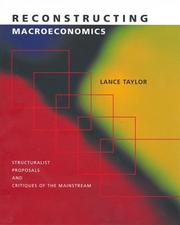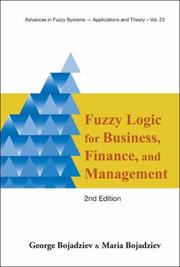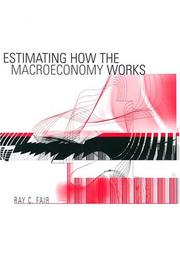| Listing 1 - 10 of 36 | << page >> |
Sort by
|

ISBN: 0415321387 0415407095 9786610225088 1134357117 1280225084 0203486617 9780203486610 9780415321389 6610225087 0203602013 9781134357116 9781134357062 1134357060 9781134357109 1134357109 9780415407090 9781280225086 Year: 2005 Publisher: London ; New York : Routledge,
Abstract | Keywords | Export | Availability | Bookmark
 Loading...
Loading...Choose an application
- Reference Manager
- EndNote
- RefWorks (Direct export to RefWorks)
Originally published in 1951, this volume reprints the classic work written by one of the leading global econometricians.Econometrics is structured as followed:Part 1 explains the relationship of Econometrics to Economics and Statistics.Part 2 outlines the process of formulating economic hypotheses mathematically and of subjecting them to a statistical test.Part 3 deals with the various component equations of the economic system - the psychic reactions, technical relations and reactions of business life and describes the process of setting up an economic model of the system as
AA / International- internationaal --- 303.8 --- Econometrics --- 330.015195 --- Economics, Mathematical --- Statistics --- Econometrische behandeling van een onderwerp. --- Econometrics. --- Economics, Mathematical. --- Economics --- Mathematical economics --- Mathematics --- Methodology --- Econometrische behandeling van een onderwerp
Book
ISBN: 1614993750 9781614993759 9781614993742 Year: 2014 Publisher: Amsterdam
Abstract | Keywords | Export | Availability | Bookmark
 Loading...
Loading...Choose an application
- Reference Manager
- EndNote
- RefWorks (Direct export to RefWorks)
This book presents the proceedings of the 21st NextMed/MMVR conference, held in Manhattan Beach, California, in February 2014. These papers describe recent developments in medical simulation, modeling, visualization, imaging, haptics, robotics, sensors, interfaces, and other IT-enabled technologies that benefit healthcare. The wide range of applications includes simulation for medical education and surgical training, information-guided therapies, mental and physical rehabilitation tools, and intelligence networks. Since 1992, Nextmed/MMVR has engaged the problem-solving abilities of scientists
Medical education --- Medical informatics --- Virtual reality in medicine --- 616 --- Geneeskunde --- Diagnose --- Therapie (behandeling) --- Medische technologie --- Chirurgie --- Informatieverwerking --- Simulaties --- Pathology. Clinical medicine

ISBN: 1280346868 9786610346868 354029936X 3540276939 Year: 2006 Publisher: Berlin, Heidelberg : Springer Berlin Heidelberg : Imprint: Springer,
Abstract | Keywords | Export | Availability | Bookmark
 Loading...
Loading...Choose an application
- Reference Manager
- EndNote
- RefWorks (Direct export to RefWorks)
Network problems are manifold and extremely complex. Many problems result from engineering details or mathematical difficulties, others are caused by disregarding economic principles and imperfections of markets. The text provides a fairly integrated approach of transportation related "network problems" and their "solutions" with emphasis on economics or, more precisely, microeconomic theory.
Transportation --- Network analysis (Planning) --- Planning --- Mathematical models. --- Project networks --- Microeconomics. --- Mathematical optimization. --- Optimization. --- Price theory --- Economics --- Optimization (Mathematics) --- Optimization techniques --- Optimization theory --- Systems optimization --- Mathematical analysis --- Maxima and minima --- Operations research --- Simulation methods --- System analysis --- AA / International- internationaal --- 303.8 --- 385.0 --- Econometrische behandeling van een onderwerp. --- Vervoerwezen, verkeerswegen en -middelen: algemeenheden. --- Econometrische behandeling van een onderwerp --- Vervoerwezen, verkeerswegen en -middelen: algemeenheden

ISBN: 1621986810 1280823585 9786610823581 1847350380 9781847350381 9781621986812 9781859574980 185957498X 9781280823589 6610823588 Year: 2005 Publisher: Shawbury Rapra Technology
Abstract | Keywords | Export | Availability | Bookmark
 Loading...
Loading...Choose an application
- Reference Manager
- EndNote
- RefWorks (Direct export to RefWorks)
Polymers --- Polymer degradation --- Deterioration. --- kunststoffen --- polymeren --- recyclage --- thermische behandeling --- 678.7 --- thermische behandelingen --- 678.7 Synthetic polymerization products. Polymerizates. Synthetic rubbers --- Synthetic polymerization products. Polymerizates. Synthetic rubbers --- Deterioration --- Synthetische polymerisatieproducten. Polymerisaten. Synthetisch rubber

ISBN: 1280901721 9786610901722 4431459782 4431459774 443154643X Year: 2007 Publisher: Tokyo : Springer Japan : Imprint: Springer,
Abstract | Keywords | Export | Availability | Bookmark
 Loading...
Loading...Choose an application
- Reference Manager
- EndNote
- RefWorks (Direct export to RefWorks)
In August 2005, a small but important conference took place at Chuo University in Tokyo, Japan. This international conference, the Chuo Meeting on Economics of Time and Space 2005 (Chuo METS 05), aimed to enrich the respective disciplines of the economics of time (dynamic economics) and the economics of space (spatial economics) and to expand their applicability in the real world. The chapters contained herein are based on the papers presented at that conference. Part I of the book deals with Keynesian macrodynamics, which allows for the existence of involuntary unemployment; Part II focuses on nonlinear dynamics, with an emphasis on the complexity that is generated as a result of the nonlinearity of the system; Part III consists of an empirical analysis of spatial economics through geographical relationships with economic activity; and Part IV analyzes the effects of spatial competition between economic organizations or agents on economic performance in a region.
Space in economics --- Time and economic reactions --- Time lag and economics --- Economics --- Statics and dynamics (Social sciences) --- Economics. --- Regional economics. --- Economics, general. --- Regional/Spatial Science. --- Regional planning --- Regionalism --- Economic theory --- Political economy --- Social sciences --- Economic man --- AA / International- internationaal --- 303.8 --- -Space in economics --- -Economics --- -330.0151 --- Spatial economics --- Regional economics --- Econometrische behandeling van een onderwerp. --- Mathematical models --- Management science. --- Spatial economics. --- Quantitative business analysis --- Management --- Problem solving --- Operations research --- Statistical decision --- Econometrische behandeling van een onderwerp --- -Mathematical models

ISBN: 0674010736 0674044231 9780674044234 9780674010734 Year: 2004 Publisher: Cambridge, Mass. Harvard University Press
Abstract | Keywords | Export | Availability | Bookmark
 Loading...
Loading...Choose an application
- Reference Manager
- EndNote
- RefWorks (Direct export to RefWorks)
Macroeconomics is in disarray. No one approach is dominant, and an increasing divide between theory and empirics is evident. This book presents both a critique of mainstream macroeconomics from a structuralist perspective and an exposition of modern structuralist approaches. The fundamental assumption of structuralism is that it is impossible to understand a macroeconomy without understanding its major institutions and distributive relationships across productive sectors and social groups. Lance Taylor focuses his critique on mainstream monetarist, new classical, new Keynesian, and growth models. He examines them from a historical perspective, tracing monetarism from its eighteenth-century roots and comparing current monetarist and new classical models with those of the post-Wicksellian, pre-Keynesian generation of macroeconomists. He contrasts the new Keynesian vision with Keynes's General Theory, and analyzes contemporary growth theories against long traditions of thought about economic development and structural change. Table of Contents: Acknowledgments Introduction 1. Social Accounts and Social Relations 1. A Simple Social Accounting Matrix 2. Implications of the Accounts 3. Disaggregating Effective Demand 4. A More Realistic SAM 5. Stock-Flow Relationships 6. A SAM and Asset Accounts for the United States 7. Further Thoughts 2. Prices and Distribution 1. Classical Macroeconomics 2. Classical Theories of Price and Distribution 3. Neoclassical Cost-Based Prices 4. Hat Calculus, Measuring Productivity Growth, and Full Employment Equilibrium 5. Mark-up Pricing in the Product Market 6. Efficiency Wages for Labor 7. New Keynesian Crosses and Methodological Reservations 8. First Looks at Inflation 3. Money, Interest, and Inflation 1. Money and Credit 2. Diverse Interest Theories 3. Interest Rate Cost-Push 4. Real Interest Rate Theory 5. The Ramsey Model 6. Dynamics on a Flying Trapeze 7. The Overlapping Generations Growth Model 8. Wicksell's Cumulative Process Inflation Model 9. More on Inflation Taxes 4. Effective Demand and Its Real and Financial Implications 1. The Commodity Market 2. Macro Adjustment via Forced Saving and Real Balance Effects 3. Real Balances, Input Substitution, and Money Wage Cuts 4. Liquidity Preference and Marginal Efficiency of Capital 5. Liquidity Preference, Fisher Arbitrage, and the Liquidity Trap 6. The System as a Whole 7. The IS/LM Model 8. Keynes and Friends on Financial Markets 9. Financial Markets and Investment 10. Consumption and Saving 11 "Disequilibrium" Macroeconomics 12. A Structuralist Synopsis 5. Short-Term Model Closure and Long-Term Growth 1. Model "Closures" in the Short Run 2. Graphical Representations and Supply-Driven Growth 3. Harrod, Robinson, and Related Stories 4. More Stable Demand-Determined Growth 6. Chicago Monetarism, New Classical Macroeconomics, and Mainstream Finance 1. Methodological Caveats 2. A Chicago Monetarist Model 3. A Cleaner Version of Monetarism 4. New Classical Spins 5. Dynamics of Government Debt 6. Ricardian Equivalence 7. The Business Cycle Conundrum 8. Cycles from the Supply Side 9. Optimal Behavior under Risk 10. Random Walk, Equity Premium, and the Modigliani-Miller Theorem 11. More on Modigliani-Miller 12. The Calculation Debate and Super-Rational Economics 7. Effective Demand and the Distributive Curve 1. Initial Observations 2. Inflation, Productivity Growth, and Distribution 3. Absorbing Productivity Growth 4. Effects of Expansionary Policy 5. Financial Extensions 6. Dynamics of the System 7. Comparative Dynamics 8. Open Economy Complications 8. Structuralist Finance and Money 1. Banking History and Institutions 2. Endogenous Finance 3. Endogenous Money via Bank Lending 4. Money Market Funds and the Level of Interest Rates 5. Business Debt and Growth in a Post-Keynesian World 6. New Keynesian Approaches to Financial Markets 9. A Genus of Cycles 1. Goodwin's Model 2. A Structuralist Goodwin Model 3. Evidence for the United States 4. A Contractionary Devaluation Cycle 5. An Inflation Expectations Cycle 6. Confidence and Multiplier 7. Minsky on Financial Cycles 8. Excess Capacity, Corporate Debt Burden, and a Cold Douche 9. Final Thoughts 10. Exchange Rate Complications 1. Accounting Conundrums 2. Determining Exchange Rates 3. Asset Prices, Expectations, and Exchange Rates 4. Commodity Arbitrage and Purchasing Power Parity 5. Portfolio Balance 6. Mundell-Fleming 7. IS/LM Comparative Statics 8. UIP and Dynamics 9. Open Economy Monetarism 10. Dornbusch 11. Other Theories of the Exchange Rate 12. A Developing Country Debt Cycle 13. Fencing in the Beast 11. Growth and Development Theories 1. New Growth Theories and Say's Law 2. Distribution and Growth 3. Models with Binding Resource or Sectoral Supply Constraints 4. Accounting for Growth 5. Other Perspectives 6. The Mainstream Policy Response 7. Where Theory Might Sensibly Go References Index Reconstructing Macroeconomics is a stunning intellectual achievement. It surveys an astonishing range of macroeconomic problems and approaches in a compact, coherent critical framework with unfailing depth, wit, and subtlety. Lance Taylor's pathbreaking work in structural macroeconomics and econometrics sets challenging standards of rigor, realism, and insight for the field. Taylor shows why the structuralist and Keynesian insistence on putting accounting consistency, income distribution, and aggregate demand at the center of macroeconomic analysis is indispensable to understanding real-world macroeconomic events in both developing and developed economies. The book is full of new results, modeling techniques, and shrewd suggestions for further research. Taylor's scrupulous and balanced appraisal of the whole range of macroeconomic schools of thought will be a source of new perspectives to macroeconomists of every persuasion.--Duncan K. Foley, New School UniversityLance Taylor has produced a masterful and comprehensive critical survey of existing macro models, both mainstream and structuralist, which breaks considerable new ground. The pace is brisk, the level is high, and the writing is entertaining. The author's sense of humor and literary references enliven the discussion of otherwise arcane and technical, but extremely important, issues in macro theory. This book is sure to become a standard reference that future generations of macroeconomists will refer to for decades to come.--Robert Blecker, American UniversityWhile there are other books dealing with heterodox macroeconomics, this book surpasses them all in the quality of its presentation and in the careful treatment and criticism of orthodox macroeconomics including its recent contributions. The book is unique in the way it systematically covers heterodox growth theory and its relations to other aspects of heterodox macroeconomics using a common organizing framework in terms of accounting relations, and in the way it compares the theories with mainstream contributions. Another positive and novel feature of the book is that it takes a long view of the development of economic ideas, which leads to a more accurate appreciation of the real contributions by recent theoretical developments than is possible in a presentation that ignores the history of macroeconomics.--Amitava Dutt, University of Notre Dame
Macroeconomics --- Mathematical models --- AA / International- internationaal --- 304.4 --- 331.05 --- 303.8 --- 331.04 --- 304.2 --- Cyclische veranderingen. --- Econometrische analyse van de economische bewegingen en cycli. --- Econometrische behandeling van een onderwerp. --- Langdurige bewegingen. --- Trendanalyse. Tendenties van lange duur. --- Macroeconomics. --- Mathematical models. --- Economics --- Econometrische behandeling van een onderwerp --- Trendanalyse. Tendenties van lange duur --- Cyclische veranderingen --- Langdurige bewegingen --- Econometrische analyse van de economische bewegingen en cycli --- Macroeconomics - Mathematical models

ISBN: 9812706496 9786611121785 1281121789 9812770623 9789812770622 9789812706492 Year: 2007 Volume: v. 23 Publisher: Hackensack, NJ : World Scientific,
Abstract | Keywords | Export | Availability | Bookmark
 Loading...
Loading...Choose an application
- Reference Manager
- EndNote
- RefWorks (Direct export to RefWorks)
This is truly an interdisciplinary book for knowledge workers in business, finance, management and socio-economic sciences based on fuzzy logic. It serves as a guide to and techniques for forecasting, decision making and evaluations in an environment involving uncertainty, vagueness, impression and subjectivity. Traditional modeling techniques, contrary to fuzzy logic, do not capture the nature of complex systems especially when humans are involved. Fuzzy logic uses human experience and judgement to facilitate plausible reasoning in order to reach a conclusion. Emphasis is on applications pres
Decision-making. --- Decision making --- Business forecasting --- Fuzzy logic --- System analysis --- Management --- Business & Economics --- Management Theory --- Data processing --- AA / International- internationaal --- 303.8 --- Econometrische behandeling van een onderwerp. --- Fuzzy logic. --- System analysis. --- Data processing. --- Network theory --- Systems analysis --- Nonlinear logic --- Business --- Business forecasts --- Forecasting, Business --- Forecasting --- System theory --- Mathematical optimization --- Fuzzy mathematics --- Logic, Symbolic and mathematical --- Fuzzy systems --- Economic forecasting --- Econometrische behandeling van een onderwerp --- Network analysis --- Network science

ISBN: 0674015460 0674036638 9780674036635 9780674015463 Year: 2004 Publisher: Cambridge, Mass Harvard University Press
Abstract | Keywords | Export | Availability | Bookmark
 Loading...
Loading...Choose an application
- Reference Manager
- EndNote
- RefWorks (Direct export to RefWorks)
Macroeconomics tries to describe and explain the economywide movement of prices, output, and unemployment. The field has been sharply divided among various schools, including Keynesian, monetarist, new classical, and others. It has also been split between theorists and empiricists. Ray Fair is a resolute empiricist, developing and refining methods for testing theories and models. The field cannot advance without the discipline of testing how well the models approximate the data. Using a multicountry econometric model, he examines several important questions, including what causes inflation, how monetary authorities behave and what are their stabilization limits, how large is the wealth effect on aggregate consumption, whether European monetary policy has been too restrictive, and how large are the stabilization costs to Europe of adopting the euro. He finds, among other things, little evidence for the rational expectations hypothesis and for the so-called non-accelerating inflation rate of unemployment (NAIRU) hypothesis. He also shows that the U.S. economy in the last half of the 1990s was not a "new age" economy.
Macroeconomics. --- AA / International- internationaal --- 305.95 --- 305.7 --- 303.8 --- Economics --- Econometrie van de lonen en de prijzen (inflatie). --- Econometrie van het gedrag van de financiële tussenpersonen. Monetaire econometrische modellen. Monetaire agregaten. vraag voor geld. Krediet. Rente. --- Econometrische behandeling van een onderwerp. --- Macroeconomics --- Econometrische behandeling van een onderwerp --- Econometrie van het gedrag van de financiële tussenpersonen. Monetaire econometrische modellen. Monetaire agregaten. vraag voor geld. Krediet. Rente --- Econometrie van de lonen en de prijzen (inflatie)

ISBN: 1280608110 9786610608119 0387283927 0387235302 0387225382 9780387235301 9780387225388 Year: 2005 Publisher: New York, NY : Springer New York : Imprint: Springer,
Abstract | Keywords | Export | Availability | Bookmark
 Loading...
Loading...Choose an application
- Reference Manager
- EndNote
- RefWorks (Direct export to RefWorks)
Sustainability of pension systems, intergeneration fiscal equity under population aging, and accounting for health care benefits for future retirees are examples of problems that cannot be solved without understanding the nature of population forecasts and their uncertainty. Similarly, the accuracy of population estimates directly affects both the distributions of formula-based government allocations to sub-national units and the apportionment of political representation. The book develops the statistical foundation for addressing such issues. Areas covered include classical mathematical demography, event history methods, multi-state methods, stochastic population forecasting, sampling and census coverage, and decision theory. The methods are illustrated with empirical applications from Europe and the U.S. For statisticians the book provides a unique introduction to demographic problems in a familiar language. For demographers, actuaries, epidemiologists, and professionals in related fields, the book presents a unified statistical outlook on both classical methods of demography and recent developments. To facilitate its classroom use, exercises are included. Over half of the book is readily accessible to undergraduates, but more maturity may be required to benefit fully from the complete text. Knowledge of differential and integral calculus, matrix algebra, basic probability theory, and regression analysis is assumed. Juha M. Alho is Professor of Statistics, University of Joensuu, Finland, and Bruce D. Spencer is Professor of Statistics and Faculty Fellow at the Institute for Policy Research, Northwestern University. Both have contributed extensively to statistical demography and served in advisory roles and as statistical consultants in the field.
Demography --- Population --- Population forecasting --- Statistical methods. --- Mathematical models. --- Forecasting, Population --- Population projection --- Population projections --- Projection, Population --- Projections, Population --- Social prediction --- Forecasting --- Mathematical statistics --- Demography. --- Epidemiology. --- Population. --- Mathematical statistics. --- Population Economics. --- Statistical Theory and Methods. --- Mathematics --- Statistical inference --- Statistics, Mathematical --- Statistics --- Probabilities --- Sampling (Statistics) --- Human population --- Human populations --- Population growth --- Populations, Human --- Economics --- Human ecology --- Sociology --- Malthusianism --- Diseases --- Public health --- Historical demography --- Social sciences --- Vital statistics --- Statistical methods --- AA / International- internationaal --- 307.10 --- 303.8 --- Algemene statistieken van de demografie. --- Econometrische behandeling van een onderwerp. --- Statistics . --- Statistical analysis --- Statistical data --- Statistical science --- Econometrics --- Mathematical models --- Algemene statistieken van de demografie --- Econometrische behandeling van een onderwerp
Book
ISBN: 9780691140025 0691140022 9786612936289 9786612473159 1400835240 128293628X 1282473158 9781400835249 Year: 2010 Publisher: Princeton Princeton University Press
Abstract | Keywords | Export | Availability | Bookmark
 Loading...
Loading...Choose an application
- Reference Manager
- EndNote
- RefWorks (Direct export to RefWorks)
Econometric models are widely used in the creation and evaluation of economic policy in the public and private sectors. But these models are useful only if they adequately account for the phenomena in question, and they can be quite misleading if they do not. In response, econometricians have developed tests and other checks for model adequacy. All of these methods, however, take as given the specification of the model to be tested. In this book, John Geweke addresses the critical earlier stage of model development, the point at which potential models are inherently incomplete. Summarizing and extending recent advances in Bayesian econometrics, Geweke shows how simple modern simulation methods can complement the creative process of model formulation. These methods, which are accessible to economics PhD students as well as to practicing applied econometricians, streamline the processes of model development and specification checking. Complete with illustrations from a wide variety of applications, this is an important contribution to econometrics that will interest economists and PhD students alike.
Econometric models --- AA / International- internationaal --- 330.3 --- 303.8 --- 305.970 --- Methode in staathuishoudkunde. Statische, dynamische economie. Modellen. Experimental economics. --- Econometrische behandeling van een onderwerp. --- Algemeenheden: Autoregression and moving average representation. ARIMA. ARMAX. Lagrange multiplier. Wald. Function (mis) specification. Autocorrelation. Homoscedasticity. Heteroscedasticity. ARCH. GARCH. Integration and co-integration. Unit roots. --- -330.015195 --- Econometrics --- Mathematical models --- Electronic information resources --- E-books --- Econometric models. --- Economic Theory --- Business & Economics --- Econometrics. --- Economics, Mathematical --- Statistics --- Econometrische behandeling van een onderwerp --- Algemeenheden: Autoregression and moving average representation. ARIMA. ARMAX. Lagrange multiplier. Wald. Function (mis) specification. Autocorrelation. Homoscedasticity. Heteroscedasticity. ARCH. GARCH. Integration and co-integration. Unit roots --- Methode in staathuishoudkunde. Statische, dynamische economie. Modellen. Experimental economics
| Listing 1 - 10 of 36 | << page >> |
Sort by
|

 Search
Search Feedback
Feedback About
About Help
Help News
News